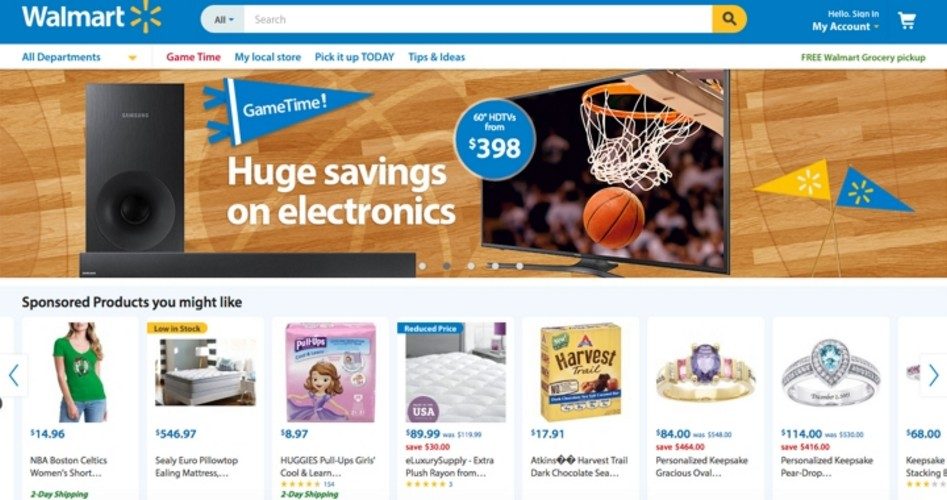
Refusing to lose market share to Amazon the way Sears, J.C. Penney, Abercrombie & Fitch, Macy’s, and Target have, Walmart is fighting back against the online retailer’s onslaught. Like two sumo wrestlers, each company is angling for a strategic advantage to counter the other’s moves.
Walmart is the world’s largest company by revenue ($485 billion in 2016) while Amazon is the world’s most valuable retailer by market capitalization ($425 billion as of March 31).
Last Thursday, Walmart moved three senior IT (information technology) people into even higher positions of authority and responsibility as the retailer responds to changing customer shopping trends. It is spending billions not only in remodeling thousands of its brick-and-mortar stores but also in building distribution centers to fill online orders. Additionally, it is expanding its online capabilities, especially in areas where Amazon has little or no presence, such as groceries and prescriptions.
Walmart’s focus is on handheld devices “as the linchpin of a customer experience that blends online and in-store shopping” noted Kim Nash, writing in The Wall Street Journal. The company is working on technologies that will let pharmacy customers order refills online through their mobile app and consequently reduce the time waiting in line to pick them up to as little as five minutes.
For those shopping for groceries online, the improved technology will not only allow for easier ordering but easier paying as well through Walmart Pay mobile payments technology. It will also announce the arrival of a customer to pick up his order so that he spends less time waiting in the store. Walmart is also expanding its non-grocery pickups as well, giving it another advantage over Amazon’s Prime, which only provides two-day delivery.
Speaking of Prime, Walmart tried a blatant frontal attack on Amazon’s Prime membership, which costs $99 a year, when it offered its Shipping Pass at $49. When that strategy failed to bring any significant portion of Amazon’s 35 million Prime customers over, it dropped the fee to zero.
Walmart has ramped up pressure on its suppliers in order to meet the company’s new objective: to have the lowest price on 80 percent of its sales. That pressure was applied to top people at Procter & Gamble (Tide, Pampers, Gillette), Unilever (Dove, Hellmann’s, Lipton), PepsiCo (Pepsi, Mountain Dew, Gatorade), Mondelez (Oreo, Nabisco, Dentyne), and Kimberly-Clark (Kleenex, Depends, Kotex) in a meeting last month near its headquarters.
In order to meet that objective, makers of these consumer packaged goods (CPGs) would have to shave at least 15 percent off their wholesale prices in order to stay on Walmart’s shelves. Otherwise, said upper management, the company would pull any products not meeting the new standard and replace them with private brands.
As a result, some products will disappear, or will stay in a package deal each CPG maker might make by cutting the wholesale prices on some of their other products to meet Walmart’s new objective. Those companies aren’t just cutting prices, but will also be redesigning packaging in order to reduce shelf space, packaging costs, and shipping expenses. They may also offer to help Walmart with customer shipping costs through online sales.
Walmart spent $3 billion last year buying Jet.com, a deep-discount online retailer, in order to bring on board its president, Marc Lore. Lore was given a mandate to do for Walmart.com what he did with Jet.com: cut 15 percent off any other online retailer’s price, including Amazon’s.
But Amazon isn’t just sitting on its hands waiting for Walmart to counter its success. While Walmart is focusing “on items customers shop the most, including household essentials such as baby necessities, pet products, food, like cereal and peanut butter, cleaning supplies and beauty favorites, as well as top electronics and toys,” according to a company spokesman, Amazon is selling the world just about everything else. As of December, Walmart offers for sale, in-store and online, 4,259,605 products. Amazon? 356,227,986 products. Or, put another way, Walmart sells just over one percent of what Amazon does. And Amazon continues to add new products as they become available.
Who is benefitting from this war of the sumo wrestlers? The simple, but incomplete answer, is: The consumers. They have more choices, faster service, more convenient shopping, lower prices, all with less hassle. In all ways that can be measured, the consumers are benefitting from this war.
As for other side effects of this war, the companies will both get larger, they will hire more people, they will pay them more (especially as they become more adept with both companies’ increasing concentration on technology), and their stockholders will enjoy better returns.
But none of those side benefits would happen without the consumers, who must be increasingly catered to, as they are the ones with the one thing Amazon and Walmart must have in order to thrive and prosper: money. As product choices multiply, and prices drop, the ripple effect flows out in ever-widening circles. After all, the free market is built around one single theme: How can the customer with the money be better served at lower cost?
An Ivy League graduate and former investment advisor, Bob is a regular contributor to The New American magazine and blogs frequently at LightFromTheRight.com, primarily on economics and politics. He can be reached at [email protected].



